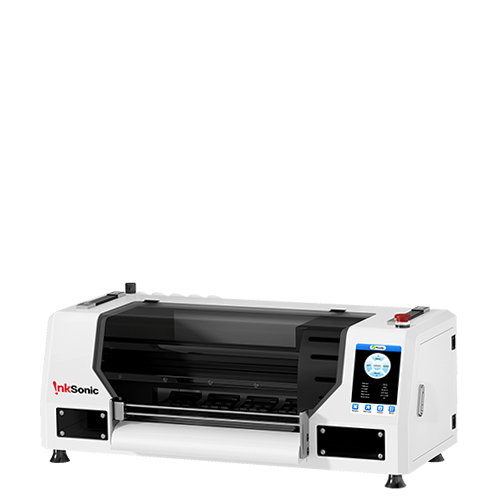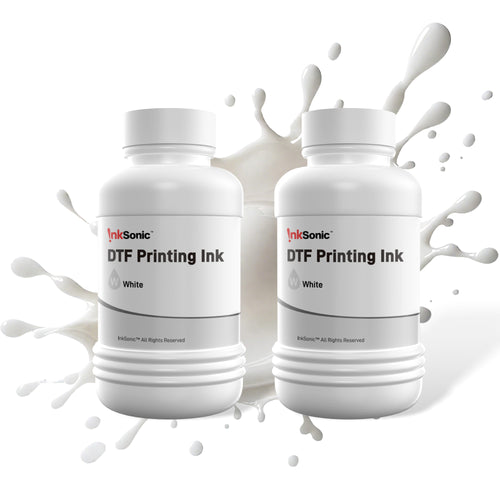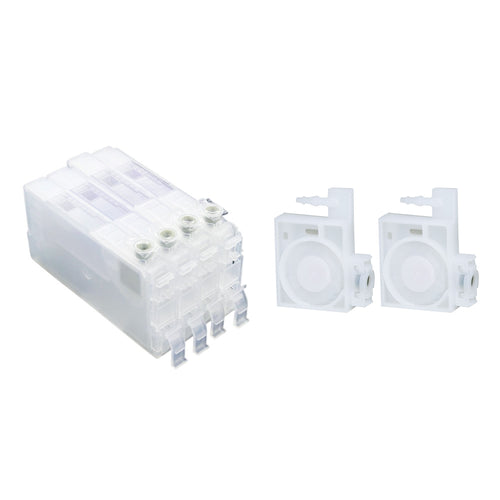You’ve spent months perfecting your designs and dialing in your sublimation prints—but you're starting to feel limited. Only white polyester shirts? Again? You’ve probably seen DTF (Direct-to-Film) prints all over social media: bold colors, soft feel, and the ability to print on cotton, black shirts, canvas totes—basically anything.
Naturally, one big question pops up: Can I use your existing sublimation printer to try DTF printing?
The short answer is technically yes, but it's definitely not ideal, and here's why.
In this article, we’ll walk you through the key differences between sublimation and DTF, what happens when you mix the two, and what you need to know before diving in.
Quick Overview of Sublimation and DTF

Sublimation
It uses dye-based ink that is made up of very fine particles. In sublimation, the ink adheres directly to the fibers of the substrate. It is generally limited to polyester or polyester-blend substrates (with polyester content generally in excess of 80%). And causes no white color printing, it's best on light-colored backgrounds.
For example:
- Drawing yellow on white paper—there it is in plain sight.
- Dyeing yellow onto black fabric—it's far from effective because the black will pull in the yellow, diminishing color contrast.

DTF Printing
On the other hand, uses pigment ink, which comprises larger particles. It also uses a white underbase layer during printing.
Then, the design is applied on top of the fabric surface once the transfer is done. Therefore, you do not have to worry about fabric color or type.
In case the color appears too light, it can be changed via the printer driver.

Overview of the Advantages and Key Considerations
The Advantage of DTF Printing (Direct to Film)
Item |
Description |
Wide material compatibility |
Works on cotton, blends, denim, dark fabrics, and more |
Supports white ink |
Allows vibrant prints on dark garments |
Vivid color output |
Pigment ink offer brilliant, high-resolution color |
Bright and dimensional colors |
Slightly raised texture after pressing adds a light dimensional feel. |
Something You Need to Focus on DTF Printing
1. Multi-step process
design →printing → powder → bake → heat press – more steps than sublimation(for the first player need time to adapt)
2. Unfamiliar DTF printing Settings
For first-time users, you may need some time to learn the specialized design software for DTF printing. However, InkSonic provides video tutorials and a free support team available 24/7 to help you solve any issues.
3. Requires white ink maintenance
Needs circulation or shaking to avoid clogging and sediment, but actually, for most brands, there is auto white ink circulation to avoid clogged nozzles, like Inksonic
The Advantage of Sublimation Printing
Item |
Description |
Soft and seamless results |
No film feel; colors embed into fibers for a natural finish |
Simple workflow |
Print and press – stable and easy to operate |
Low material cost |
Inexpensive ink and transfer paper – great for mass production |
Something You Need to Focus on: Sublimation Printing
1. Limited fabric choice
Only works on light-colored polyester fabrics or coated substrates; it is not suitable for cotton.
2. No white ink
Can't produce images on dark or black fabrics
3. The printing color weakness
Because the ink particles are too small and there's no white ink to enhance other colors, sublimation printing results often look less vibrant compared to DTF printing.
Contrast and Difference
Feature |
Sublimation Printing |
DTF Printing |
Fabric Compatibility |
Light-colored polyester |
Cotton, blends, polyester, etc. |
White Ink Support |
❌ |
✅ |
Workflow Complexity |
Simple (Print & Press) |
Moderate (Multi-step) |
Vibrancy on Dark Fabric |
Poor |
Excellent |
Feel on Fabric |
Seamless |
Slight texture |
Cost Comparison: DTF vs. Sublimation — What’s the Real ROI?
When it comes to choosing between DTF and sublimation, cost is often the dealbreaker—or dealmaker. If you're building a printing business, you need to know not just which method looks better, but which one actually earns better. Let’s break it down by the numbers and look at the real cost per print for both.

Item |
DTF Printing |
Sublimation Printing |
|---|---|---|
Equipment (Starter Kit) |
$1,500 – $4,000 |
$250 – $800 |
Ink (per ml) |
~$0.05 – $0.07 |
~$0.02 – $0.04 |
Transfer Film/Paper |
DTF Film: ~$0.30 per sheet |
Sublimation Paper: ~$0.10/sheet |
Adhesive Powder |
~$0.05 per print |
Not needed |
Labor & Workflow |
Slightly longer (multi-step) |
Faster (print & press) |
Cost Per Print (avg.) |
$0.80 – $1.20 |
$0.30 – $0.60 |
So yes, sublimation may look cheaper at first glance—but that’s only part of the story. While DTF has a higher upfront cost, it also gives you more product flexibility, the ability to print on dark and cotton fabrics, and higher potential selling prices. If you're charging $20–$30 per shirt, that extra $0.50 in cost per print becomes a smart investment—not a burden.
Use Sublimation Ink on DTF Film: Is It Worth It?
- The way of trying DTF using sublimation ink also appears simple: simply substitute your sublimation paper for a DTF film, add the powder, bake, and heat press—just like in the DTF printing process.
- Even though this "DTF sublimation" technique can be made to work, after you've tried, you'll discover that the result, especially on black materials, cannot be matched by actual DTF printing in terms of vibrancy or durability.
- If your budget allows, InkBear strongly recommends upgrading to a real DTF printing setup. From broader material compatibility to higher-quality results, switching to true DTF is a smart move that can elevate your product line and give your business a fresh new boost.

While the up-front cost of a DTF printer may be expensive compared to sublimation, the long-term payoff is usually well worth it—especially for artists looking to expand their product line and elevate their profit margins. Sublimation will cost you a few pennies per print, but its limitations on fabric quality and color print will stifle your growth in a hurry.
Many small business owners learn this the hard way. Maria, who runs a custom apparel shop on Etsy, shared her experience:
“I tried converting my sublimation printer for DTF after watching a few tutorials. I thought I’d save money, but I ended up wasting film, clogging the printer, and getting poor results. Upgrading to a real DTF machine changed everything—now I can print on anything, and my sales have doubled.”
— Maria, Custom Apparel Seller
Maria’s story is just one of many. For those serious about quality and long-term returns, investing in a proper DTF setup often pays for itself faster than expected.
What You Must Know Before Trying This Workaround
- Adhesion Issues: Sublimation ink doesn't react well with the DTF adhesive powder.
- Color Fading: Even if the print initially looks okay, it tends to wash out quickly.
- Clogging Risks: Many sublimation printers aren't designed for film printing — using DTF film may increase the risk of clogs.
If you’re curious or just want to experiment, it might be fun to try — but if you’re serious about high-quality garment printing, investing in a proper DTF printer setup is the smarter move. You’ll get better results, longer-lasting prints, and access to a broader product range.
Trying to shortcut with sublimation ink on DTF film might seem tempting, but in the long run, it limits your product quality and growth.
DTF printing is not just a brand-new fad—it's a real-game-changer for any kind of creative small business owner. Independent fashion brands employ it to produce deep, vibrant color graphics on cotton T-shirts and hoodies without minimum orders or waiting for an outsourcer. Etsy sellers love it because it's so versatile: from personalized baby onesies to cool tote bags, they can print on demand and sell unique items that stand out. Sportswear decorators use DTF to create effective, durable prints on team tees, fan wear, and custom emblems—now even on performance apparel.
FAQ
1. Is a DTF printer expensive?
Entry-level DTF printers are now more affordable, especially desktop models. Prices start around $1,500–$4,000 for different demands.
2. Is DTF printing slow?
Not at all. Many new models offer fast print speeds with automatic powder shaking and film curing.
3. What's the lifespan of a DTF print?
With proper care, DTF prints last 80+ washes, often outlasting traditional heat transfer vinyl or even sublimation on light polyester.
4. Is DTF printing hard to learn?
With the right machine and tutorial support, even beginners can master it within days.
5. What’s the real DTF printing cost per print?
Usually $0.50 to $1.00 for a full front design, including film, ink, and powder — highly cost-effective for custom tees.
6. Is the Sublimation printer used with DTF ink?
Not recommended, as DTF ink typically contains larger pigment particles compared to sublimation ink, which would make it more likely for the pipelines of the printer to be clogged. Additionally, sublimation printers do not have a white ink channel and thus cannot achieve the same result as a true DTF printer.
If you are serious about printing on more than polyester and growing your custom merch business, skip the hacks — invest in a real DTF printer.

































